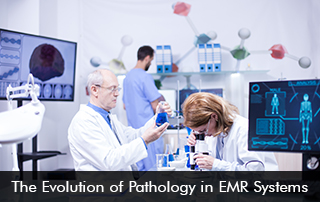Pathology plays a crucial role in the diagnosis and treatment of various diseases. It is an ever-evolving field, especially post-COVID. EMR software has become an indispensable tool to ensure workflow efficiency, diagnostic accuracy, and the overall quality of patient care.
Enhancing Efficiency in Pathology Workflows
Streamlined Documentation – EMR software simplifies the documentation process for pathologists. In fact, it allows for efficient capture, organization, and retrieval of patient data. This includes specimen details, lab test results, and clinical history. All this allows for streamlined workflows, reduced paperwork, and faster access to critical information.
Improved Access to Patient Data – EMR software provides pathologists with centralized access to patient records. This is especially handy during comprehensive data review. With a few clicks, doctors can retrieve and analyze historical data, aiding in accurate diagnosis, treatment planning, and monitoring patient progress over time.
Automated Workflows – Additionally, EMR software automates various aspects of pathology workflows. Tasks such as result entry, sample tracking, and report generation are all autmated. As a result of reduced manual tasks, pathologists are free to focus on complex cases, quality assurance, and research activities.
Enhancing Diagnostic Accuracy and Patient Safety
Advanced Image Analysis – EMR software integrated with digital imaging systems enables pathologists to analyze digital slides and images. Advanced image analysis algorithms can aid in detecting subtle abnormalities. As a result, pathologists provide improved diagnostic accuracy and reduced chances of missed diagnoses.
Decision Support Tools – Furthermore, EMR software provides pathologists with decision support tools. With access to relevant clinical guidelines, research articles, and reference materials, pathologists can make informed decisions. This is true especially when faced with complex cases or rare conditions.
Quality Control and Standardization – EMR software allows for the implementation of standardized protocols and quality control measures. It enables consistent reporting and adherence to best practices. It also helps identify and rectify potential errors or inconsistencies in the diagnostic process.
Facilitating Collaboration and Communication
Interdepartmental Collaboration – EMR software promotes seamless collaboration between pathology departments and healthcare professionals. It enables sharing of patient data, test results, and diagnostic reports across different specialties. It also helps to foster interdisciplinary care and better patient outcomes.
Remote Consultations – EMR software facilitates remote consultations between pathologists, allowing for timely expert opinions and second opinions. This enhances diagnostic accuracy, particularly in challenging cases where collaboration and knowledge-sharing are essential.
Patient Engagement and Education – Finally, EMR software can enable patients to access their pathology reports securely. Pathologists can communicate results, explanations, and treatment recommendations directly to patients, fostering patient engagement and enhancing their understanding of their condition.







